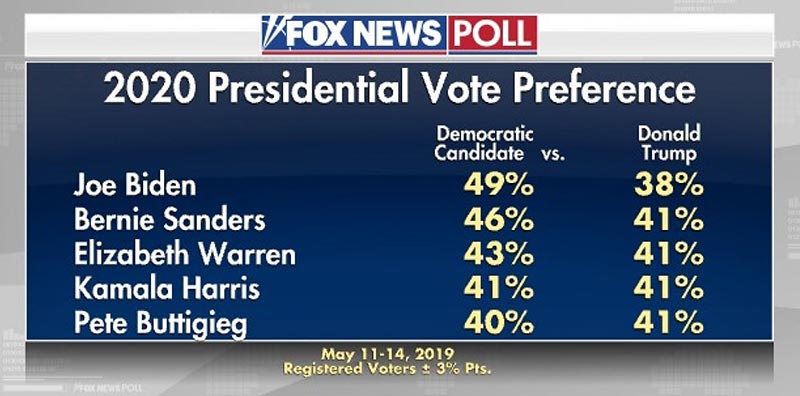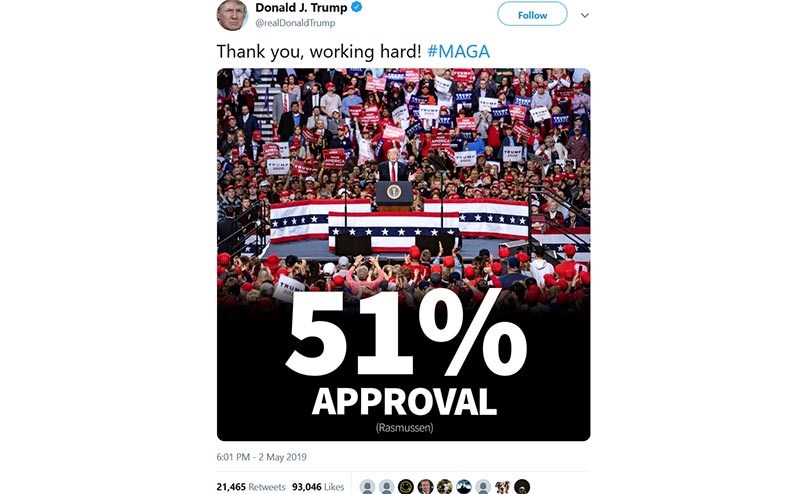A poll released by Fox News in May 2019 pitting Trump against top Democratic candidates—Biden, Sanders, Warren, Harris and Buttigieg—made a number of journalists, commentators, and armchair analysts raise their eyebrows a bit.
 As G. Elliot Morris, a data journalist for the The Economist put it, “Listen, it’s a long way til 2020, but these numbers are really not great for Trump.” At face value, it’s fairly evident why. Among those polled, Biden trounced Trump by 11 points, while Sanders beat him by a respectable 5. Even paired against candidates averaging 6 to 8 points in recent Democratic primary polling, the margin (ranging from Warren winning by 2 to Buttigieg losing by 1) fell well within the margin of error. An incumbent president being ahead 1 point versus the 37-year-old gay mayor of a town with a population of just over 100,000 is not a performance to inspire confidence.
As G. Elliot Morris, a data journalist for the The Economist put it, “Listen, it’s a long way til 2020, but these numbers are really not great for Trump.” At face value, it’s fairly evident why. Among those polled, Biden trounced Trump by 11 points, while Sanders beat him by a respectable 5. Even paired against candidates averaging 6 to 8 points in recent Democratic primary polling, the margin (ranging from Warren winning by 2 to Buttigieg losing by 1) fell well within the margin of error. An incumbent president being ahead 1 point versus the 37-year-old gay mayor of a town with a population of just over 100,000 is not a performance to inspire confidence.
As an aside: Regardless of your (and my) opinion about Fox News, it should be noted that going back many years, Fox News has commissioned excellent, top-tier polls. Yeah, I know. Don’t ask me why. Say what you will, their polls are really good.
But let’s take a step back and acknowledge something: Early head-to-head polls are crap.
It’s common knowledge among polling analysts and just about anyone who pays attention to polls knows that early polls are garbage. And analysis shows it. A few years ago Christopher Wlezien, now a professor at UT Austin, ran an analysis of presidential election polls conducted as early as 300 days before a general election. In his analysis, he compared each poll versus the final outcome, and calculated the average r-squared (R²) value, also known as the coefficient of determination, for polls conducted n days before an election.
R-squared is an indicator of how tightly related two numbers are to one another, and is represented as a decimal between 0 and 1. A R-squared of 0 means two things are entirely unrelated to one another, and 1 means two things are perfectly and entirely related to one another. A pretty good R-squared value is anything above 0.7.
In this context, R-squared gives an indication of how accurately a poll predicted the outcome—not just in terms of who won, but what the final margin was. Saying someone would win by 2 points when they went on to win by 12 would be pretty useless (after all, if you missed in the other direction, in addition to missing the margin of victory badly, you’d also call the wrong victor). Polls with an R-squared of 0 would have absolutely no predictive value, while polls with an R-squared of 1 would mean that Doc Brown probably needed to check to make sure someone hadn’t stolen the keys to his DeLorean.
Wlezien’s analysis found that early polls were utter trash. 300 days out, they had R-squared values literally just above zero. In other words, scarcely better than having a psychic octopus pick the winner. Polls didn’t cross that desirable 0.7 line until around 80 days before the general election.
Now, for some perspective, on the day the Fox News poll came out, the Democratic Iowa caucus was 263 days away. The 2020 general election being forecast by the Fox News poll? 537 days away.
So, yeah. Trash. But, G. Elliot Morris and his peers were well aware of this. So, why did they react? Well…
Historically speaking, Trump’s poll numbers are such a dumpster fire that they still have relevance in the context of previous elections.
In the Fox News poll, Trump’s support maxes out at 41%, hitting that figure against 4 opponents, despite their support ranging between 40% and 46%. Despite voters being polled increasingly asking the question “Butt-a-who?” as the pollster worked their way down into lesser known candidates, a large portion of people simply opted to not commit to anyone, rather than backing Trump.
Let’s give some context for this 41% figure by looking at some head-to-head polling for the 2012 election, the last election where an incumbent (Barack Obama) faced a challenger (Mitt Romney). RealClearPolitics has an archive of 298 polls pitting the two candidates against one another, conducted between January 3, 2011 and November 5, 2012. I’ve excluded a couple dozen polls conducted in 2009 and 2010, as that’s… really damn early.
Of the 298 polls pitting Obama against Romney, how many of them had Obama with support of 41% or less? Well, uh… two.
Obama never polled at 41%, but did poll at 42% in 14 polls. (Note that we’re being a little gracious to Donald Trump here by using the 41% he mustered against the non-front-runner candidates, rather than the paltry 38% he had versus Joe Biden.)
If the name Rasmussen rings a bell, it’s likely because it’s the polling company beloved by Donald Trump for it’s predictably more optimistic than average perspective on his performance.

The 51% support figure touted by Trump here on May 2, 2019 was the highest figure he’d gotten from Rasmussen since April 17th. Two weeks later, Rasmussen showed him at 45%.
Rasmussen did rather poorly in 2018, when the company estimated that Democrats had a 1.7% advantage just prior to the congressional election, rather than the 8.6% popular vote margin they actually enjoyed on election day.
Given the pollster’s track record, it’s reasonably safe to say that it’s meaningful that the two lowest support figures that Obama received out of 298 polls, over a nearly 2 year period, were from Rasmussen. But despite that polling company perhaps putting their finger on the scales just a bit, Obama only hit or fell below that 41% figure 2 times out of 298 polls.
But hey, maybe polls are biased in the favor of liberals, and Republican presidents are always at a disadvantage.
Let’s take a look at polls from the previous incumbent who campaigned for reelection, George W. Bush in 2004.
Sadly, we don’t have quite as many polls for Bush versus John Kerry, nor as large of a date range. But the data set is still pretty good. RealClearPolitics has 233 polls comparing support for Bush and Kerry, conducted between January 28th and November 1st of 2011. In those polls, Bush hit or fell beneath the 41% mark more often than Obama did, but not by much—only 6 times. Bush had 3 polls with 41% support, 2 with 40%, and 1 with 37%. The one with 37% was apparently from a poll by InsiderAdvantage, a rather low-tier publication I had not heard of previously, and which doesn’t appear to conduct its own polling anymore. I would feel comfortable tossing this poll out, but there’s no need. Even though Bush had low support a little more often that Obama did, it was still a serious rarity, happening in only 2.6% of polls conducted that year.
But hold on. I’ve noted that Obama had support equal to or below 41% three times, and Bush did 6 times. But I’m only citing a single poll showing Trump at that level. Maybe this is just his odd one out? The anti-Rasmussen?
How is Trump performing in head-to-head polling thus far?
Well, we already have a small amount of horse race polling for the 2020 election to get an idea of how Trump is faring. Again, I turned to RCP for my data set. (Note: A large number of the polls on hand were conducted by Public Policy Polling, a Democratic polling firm. Despite the fact that they have a respectable track record, I opted to exclude these polls out of an abundance of caution.)
How has Donald Trump compared to his Democratic counterparts?
- In 12 comparisons with Joe Biden, Trump has polled at or below 40% five times. His low mark? 34%.
- In 9 comparisons with Bernie Sanders, Trump has polled at 41% two times, his low mark against Sanders.
- In 9 comparisons with Elizabeth Warren, Trump has polled at 41% once, his low mark.
- In 8 comparisons with Kamala Harris, Trump has polled at 41% twice, his low mark.
- In 5 comparisons with Pete Buttigieg, Trump has polled at 41% once, his low mark.
Suffice to say, that’s pretty striking.
When you look at the polling margins, things get even more depressing looking for Trump.
In the 298 polls of Obama vs. Romney, Obama trailed in about 19.5% of the polls. His worst polls were two in which he trailed by 6 points… and both of those polls were conducted by Rasmussen. The next worst was a single poll conducted by Gallup where he trailed by 5 points.
George W. Bush didn’t fare quite as well as Obama, but he certainly didn’t come close to where Trump is at right now. Bush trailed in 76 polls, or about 32.6% of polls. Out of all those polls, there was only one instance where he trailed by double digits, and 13 polls where he trailed by 5 or more.
In the 43 head-to-head polls pairing Trump up with the 5 candidates named above, Trump has only led in 9. He’s trailed in 79.1% of them. Against Biden, Trump’s best performance is a poll where he trailed by 5 points. In four polls he’s trailed Biden by 10 or more points. That’s… pretty damn terrible.
But Trump isn’t doing so horribly against all the Democrats. Who are his strongest and weakest opponents?
Below is the average margin Trump has against the 5 candidates noted in the Fox News poll, from best (for Trump) to worst:
- Buttigieg: +0.80 points
- Harris: -0.88 points
- Warren: -0.89 points
- Sanders: -4.33 points
- Biden: -8.58 points
Obviously, it’s still very early to get into an analysis of whether one Democratic candidate or another should be considered by voters to have an edge in terms of that oft-dreaded and -derided term, electability. Things will change. But two things are notable here. One, Biden has a very notable edge over the rest of the candidates. One that is statistically significant. To a lesser degree, the same can be said of Sanders. (Will 2020 be a case of The Old White Guys Strike Back?)
Second, even relatively weak candidates like Harris and Buttigieg, who haven’t averaged above 8% in polls conducted in the month prior to the Fox News poll, are competitive against Trump. And none of them are performing poorly. That’s something that Republicans have to be pondering as they plot their next moves for bolstering their 2020 candidate… or perhaps positioning themselves for 2024 instead.
Politics is a nasty business, after all. And the likelihood of facing off against an octogenarian (or their vice president) has to be an enticing prospect. On Election Day 2024, Biden would be days away from his 82nd birthday. Sanders would have just turned 82. Even Elizabeth Warren, who’s currently narrowly holding third place in primary polling, would be 74, a year older than Donald Trump will be on Election Day 2020.
It’s still very early days.
